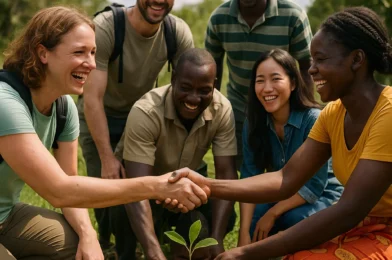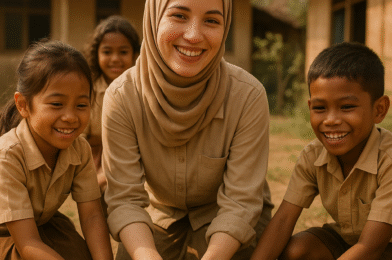You’ve done it. You’ve booked the one-way ticket, packed your life into a 50-liter backpack, and said goodbye to routine. The path ahead is unwritten, a thrilling expanse of new countries, new friendships, and endless adventure. This is the pure freedom of backpacking.
But after a few weeks of moving from city to city, from hostel to hostel, a new feeling might start to creep in alongside the excitement. You might find yourself asking, “Is this it? Is there more to travel than just seeing the sights and moving on?”
The answer is a resounding yes. If you’re craving a deeper connection, a way to move beyond being a mere spectator and become an active participant in the places you visit, then it’s time to discover backpacking for a purpose. This is a style of travel that seamlessly weaves meaningful service into the fabric of your adventure. It’s about adding a “why” to your “where,” transforming your journey from a self-focused trip into a richer story of mutual exchange.
This guide will show you how to combine epic travel and meaningful service, making your backpacking journey not only more affordable and longer-lasting but also infinitely more rewarding.
Why Add Purpose to Your Pack? The Benefits of Service-Oriented Backpacking
Integrating volunteer work into your travels does more than just make you feel good; it fundamentally enhances every aspect of your backpacking experience.
- Deeper Cultural Immersion: When you volunteer, you’re not just passing through a town for a day or two. You are welcomed into the daily rhythm of a place. You work alongside local people, share meals with them, and learn about their lives, their challenges, and their joys in a way that is impossible as a tourist. You stop looking at a culture from the outside and start experiencing it from within.
- Travel Longer for Less: Let’s be practical: backpacking is a marathon, not a sprint. Your biggest expenses are almost always accommodation and food. Many volunteer opportunities, especially work exchanges, offer a free bed and meals in return for a few hours of your time each day. This drastically cuts your daily budget, allowing you to extend your travels by weeks or even months.
- Learn Real-World Skills: Your volunteer work can be an education in itself. You could spend two weeks learning the principles of organic farming on a permaculture farm in Thailand, discover the art of hospitality by helping out at a family-run guesthouse in Portugal, or gain valuable construction skills while assisting on a community building project in Ecuador.
- Build a Global Community: While hostel common rooms are great for meeting other travelers, volunteering allows you to build a different kind of network. You form genuine, lasting relationships with your hosts and the local community members you work with. These are the people who will become your global family.
- Combat Travel Burnout: The constant motion of long-term travel—packing and unpacking, navigating bus stations, making new friends only to say goodbye—can be exhausting. Pausing in one place for a week or two to volunteer provides a welcome sense of routine and purpose. It can be the perfect way to recharge your batteries before you hit the road again.
The Backpacker’s Toolkit: How to Find Opportunities on the Road
The beauty of purposeful backpacking is its flexibility. You don’t necessarily need to have a formal, long-term placement. Here are the best tools for finding opportunities on the fly.
The Holy Trinity of Work Exchange
For a small annual fee, these platforms connect you with thousands of hosts around the world who are looking for volunteers. This is the ultimate backpacker’s resource.
- Workaway: This is the giant in the work exchange world. You’ll find an incredible variety of hosts, from families looking for childcare and language practice, to farmers, NGOs, eco-projects, and small businesses. The sheer volume of opportunities is its biggest strength.
- HelpX (Help Exchange): One of the original work exchange sites, HelpX is particularly strong in certain regions like Australia and New Zealand. It has a loyal following and often lists opportunities on farms, ranches, and homesteads that you might not find elsewhere.
- Worldpackers: This platform has a strong focus on the volunteer experience, often with more structured placements at hostels, guesthouses, and social projects. They offer a form of “insurance” if a host doesn’t work out and have a great community and social element.
The Classic Hostel Work-Stay
This is a time-honored backpacker tradition. If you find a hostel you love in a city you want to explore more deeply, approach the manager. Many hostels are happy to trade a free bed (and sometimes breakfast) for a few hours of work each day, whether it’s helping at the reception desk, cleaning, or leading a pub crawl. It’s a great way to save money and become a temporary local.
The Analog Method: Just Ask!
Never underestimate the power of human connection. The best opportunities often aren’t listed online.
- Talk to other travelers: The backpacker grapevine is powerful. Ask people you meet in hostels about their experiences.
- Talk to locals: Tell your guesthouse owner, the person you buy fruit from, or your local tour guide that you’re looking to lend a hand. Be open about your desire to help, and you will be amazed at the doors that open.
Popular Backpacking Routes with a Purpose
While you can find opportunities almost anywhere, some classic backpacking routes are particularly well-suited for combining travel and service.
Route 1: South America – The Andean Path
This high-altitude journey takes you through the spine of the Andes, a land of ancient Incan history, dramatic mountain landscapes, and vibrant indigenous cultures.
- The Vibe: Adventurous, rugged, and culturally rich.
- The Purposeful Path: The continent is full of possibilities. Use a work exchange to volunteer at an eco-lodge deep in the Colombian jungle. Help out at a bustling hostel in the historic center of Quito, Ecuador. Spend a few weeks teaching English to children in a small community in Peru’s Sacred Valley. Or, get your hands dirty working on a sustainable farm near Lake Titicaca in Bolivia.
Route 2: Southeast Asia – The Classic Loop
This is the quintessential backpacking experience for many. A journey through the lush landscapes, ancient temples, incredible food, and organized chaos of Thailand, Laos, Cambodia, and Vietnam.
- The Vibe: Energetic, budget-friendly, and a feast for the senses.
- The Purposeful Path: The opportunities are endless. You could spend your time supporting an ethical elephant sanctuary in Northern Thailand (be sure to research thoroughly!), helping out on a permaculture coffee farm in the hills of Laos, assisting a local NGO with community development projects in rural Cambodia, or teaching English in Vietnam.
Route 3: Australia & New Zealand – The Working Holiday Mecca
For backpackers who can get a working holiday visa, this region offers the perfect blend of long-term travel, paid work, and volunteer opportunities in some of the most stunning natural landscapes on Earth.
- The Vibe: Outdoorsy, adventurous, and a culture built around travel and exploration.
- The Purposeful Path: The work exchange scene here is massive. You can truly live like a local by helping out on a sprawling sheep station in the Australian outback, working at a world-class winery in New Zealand’s Marlborough region, or assisting with vital conservation projects to protect the unique wildlife in a national park.
The Responsible Backpacker: A Few Key Principles
Adding service to your travels also adds a layer of responsibility.
- Your Skills vs. Theirs: Approach every opportunity with humility. You are there to support and learn, not to “fix” or “save.” Be very careful not to take a role that a local person could be paid to do. Your primary role is to provide help that is otherwise unavailable.
- Commit to Your Commitment: When you agree to volunteer for a set period, honor that agreement. Leaving early can put your host in a very difficult position. They are relying on you.
- Manage Your Expectations: The work might be harder, more boring, or less glamorous than you imagined. That’s part of the experience. Embrace every task with a positive attitude.
- Leave a Good Impression: As a traveling volunteer, you are an ambassador for the entire backpacking community. Be respectful, clean, grateful, and leave your hosts with a positive story to tell about the traveler who came to stay.
Backpacking is, at its heart, about freedom. The freedom to choose your own path, to change your plans on a whim, and to define your own journey. Adding service to that journey doesn’t restrict your freedom—it deepens it. It gives it meaning. It transforms your travels from a collection of places you’ve been to a collection of connections you’ve made. So pack your bag not just with clothes and a guidebook, but with an open heart and a willingness to lend a hand. The most epic adventure is the one with purpose.
Are you a backpacker who has volunteered on the road? Share your best tip or favorite memory! Or, if you’re planning a trip, where do you dream of making an impact? Let’s talk in the comments.





